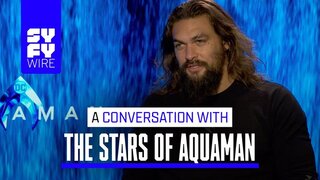Create a free profile to get unlimited access to exclusive videos, sweepstakes, and more!
The 14 Best Sci-fi Movies Streaming on Peacock: Alien, Arrival, Aquaman and More
The bird app is where sci-fi's at!
Stories are the way we talk about the things we’re not good at talking about: love, death, fear, hope... We build proxies for ourselves that are better-looking, braver, or cleverer than we are, and we put them in the situations we can only imagine in order to explore the world as it is or as we wish it could be. Science fiction, more than perhaps any other genre, extends this unique form of cultural meditation to our own possible future.
Through science fiction, we see the ways the world might one day be, and we can make mistakes on page or screen in the hope that we don’t make them when they really come knocking. Because we can only build what we can first imagine, we’d serve ourselves well by sampling the many different potential futures available in our fictions.
If you’re looking for inspiration, Peacock’s collection of science fiction movies and television series might be the perfect place to start. To be sure, not all sci-fi flicks present an ideal future, and they might serve you better as a warning than a blueprint, but either way you’re sure to have a blast along the way. There are scores of movies and hundreds of episodes of science fiction to choose from, these are but some of our favorites.
For More on Sci-Fi:
The 20 Best Sci-Fi TV Shows on Peacock Right Now: Twisted Metal, Farscape, Resident Alien & More
Gamer Was a Weird, Wild Sci-Fi Action Flick Ahead of Its Time
Say "Yes" to the 5 Best Moments from Jordan Peele's Nope
What are the best sci-fi movies now streaming on Peacock?
ALIEN
Written by Dan O’Bannon and directed by Ridley Scott, 1979’s Alien is a contender for the best science fiction film ever made. It tells the story of the crew of the Nostromo – a blue collar spacecraft in a greasy, spacefaring future – and their encounter with a vicious alien organism.
The crew is in stasis, on their way back to Earth, when the ship’s computer picks up a possible distress call and wakes them up. The crew shuffles from their too-brief rest and settles down on the surface of a nearby planetoid, where they trace the signal to a downed alien spacecraft. What they thought was a distress signal, turned out to be a final shout into the void, warning anyone else to stay away.
The movie was so successful (largely on the strength of Sigourney Weaver’s Ripley) that an entire franchise burst from its chest, birthing three sequels, two prequels, and two Predator crossovers. A standalone film titled Alien: Romulus is slated for an August 2024 release. And it all started with Alien.
ARRIVAL
Ted Chiang published his celebrated novella “Story of Your Life” in 1998. It told the story of linguist Louise Banks and her attempts to communicate with the extraterrestrials who recently perched themselves in the sky above our planet. It was nominated for the 1999 Hugo Award, won the 2000 Nebula, and was later adapted to film by director Denis Villeneuve under the title Arrival.
Amy Adams plays Louise Banks, the unassuming linguist swept into humanity’s first contact with a mysterious alien intelligence. There are some changes from the source material but the octopus-like “heptapod” aliens remain. They communicate using bizarre circular symbols which Banks works to decode, and the process changes her. It’s a story about communication and about working together, not just with alien visitors, but also with one another.
AQUAMAN
As the wave of superhero fever crested, director James Wan surfed in with a live action adaptation of DC’s Aquaman, part of the cinematic DC Extended Universe (DCEU). The movie stars Jason Momoa as the titular hero of the deep, Aquaman, aka Arthur Curry, as he fights for the fate of Atlantis and the rest of the world.
Curry is a man caught between worlds. His mother was underwater royalty, his father an ordinary man, and their forbidden love cost her life. In response, Arthur shuns his aquatic half and makes a life for himself with the surface dwellers. But Arthur returns to the deep when his brother threatens to unite the sea kingdoms against the surface world to destroy humanity.
He might be a fish out of water, as it were, a man without a country, but Arthur Curry has every aquatic creature both real and mythical at his beck and call. Turns out that’s worth a lot.
DONNIE DARKO
Richard Kelly’s 2001 cult classic, Donnie Darko, continues to demand rewatches and command late-night barguments two decades after release. Set in 1988, the titular Donnie Darko (Jake Gyllenhaal) is awoken by a mysterious voice. Following it, he encounters a creepy, humanoid rabbit named Frank who tells Donnie the world will end in 28 days, 6 hours, 42 minutes, and 12 seconds.
Strange as that encounter was, it saved Donnie from certain death when an airplane engine crashed into his bedroom. From there, a bizarre series of events unfolds involving tangent universes, multiverse artifacts, time traveling ghosts, and the entangled fates of one boy and the entire universe.
GAMER
In Gamer’s gritty view of the near future, an inventor named Ken Castle (Michael C. Hall) creates nanites capable of replacing and replicating human brain tissue. The result: complete remote control over another person’s body.
Right away, the technology is used for a real-world version of The Sims called Society, in which players manipulate living avatars. But the tech really takes off when Castle launches Slayers, a violent first-person-shooter version of Society in which players control death row inmates in very real and very deadly combat. If an inmate survives 30 matches — something in the complete control of the player — they are granted their freedom.
That’s never happened, but a new “character” named Kable (Gerard Butler) is only three matches away when the whole house of cards crumbles down around him. It presents a world which feels right next door in a sickening kind of way.
MYSTERY SCIENCE THEATER 3000
Okay, this is technically a TV show, but it's a TV show about watching movies, in full. That counts!
You never know what a new day might bring. If you’re very unlucky you might be kidnapped by a group of mad scientists, shuttled aboard an interstellar spacecraft, and forced to watch bad movies until your connection with reality shatters. If you find yourself in that situation, it helps to have a few friends. When Joel Robinson found himself in this exact unlikely but hilarious situation, and without any friends, he built some from scratch using pieces of the ship. Those friends are known as Tom Servo, Crow T. Robot, and GPC. And they, along with the human test subject, watch bad movies and crack wise to make them a little less painful. The great thing about Mystery Science Theater 3000 is it isn’t just one bad movie, but so many. So many, that eventually, they start to look pretty good. Not every episode is streaming on Peacock, but several classics, including Mitchell, Pod People, and Hercules Against the Moon Men, are.
TURBO KID
Turbo Kid isn’t, strictly speaking, a vision of the future, but we’ll let it slide because it’s INCREDIBLE. It takes place in an alternate reality 1997, in a world struggling for water. The tyrannical overlord Zeus (played perfectly by Michael Ironside) captures people from the Wasteland and crushes them to get their water. It’s a tough world to live in when you’re a kid who just wants to ride his bike and read comic books.
When The Kid meets Apple, a friendship model robot, the two of them embark on a coming of age story like none you’ve ever seen. It’s equal parts Napoleon Dynamite and Mad Max, with a disturbingly hilarious amount of blood splatter. It’s a post-apocalyptic fever dream as imagined by a Power Glove-wearing teenager from the ‘80s. It’s perfect.
UPSIDE DOWN
Juan Diego Solanas’ 2012 film, Upside Down, blurs the lines between science fiction and fantasy to tell a cosmic love story only possible in our imaginations. We enter the worlds of Upside Down through the eyes of Adam (Jim Sturgess). He’s an ordinary guy in extraordinary circumstances, a citizen of a binary planet system with an impossible gravitational relationship.
The two worlds, known only as Up and Down, share a gravitational field, allowing them to orbit in incredibly close proximity to one another. But that doesn’t mean that residents of the two worlds travel freely between them. On these worlds, matter adheres to a few seemingly inalienable rules. First and most important: All matter is only attracted to the gravity of its home world. Second: Matter can be counterbalanced by “inverse” matter from the opposing world. Finally: Contact with inverse matter is temporary and results in spontaneous combustion after a few hours.
Adam might have been satisfied to live out his life on one world, but when he meets Eden (Kirsten Dunst), a woman from Up, they set about rewriting both the laws of their society and the laws of physics.
THE INVISIBLE MAN (2020)
From 1931 until 1956, Universal Pictures released 41 movies in their classic monster series. The popular image of creatures from Dracula and the Wolfman to Frankenstein and the Mummy are defined in large part by those films. Unlike other creatures from the Universal pantheon, the Invisible Man is the result of science gone wrong.
In H.G. Wells’ original story and the 1933 adaptation, his character relies on chemistry to render himself invisible. The 2020 adaptation, directed by Leigh Whannel (Upgrade, Insidious: Chapter 3) and starring Elizabeth Moss (The Handmaid’s Tale) and Oliver Jackson-Cohen (The Haunting of Hill House) replaces chemistry with advanced optics.
When Cecilia Kass (Moss) leaves her abusive partner Adrian Griffin (Jackson-Cohen) she thinks she’s finally free. That feeling is reinforced when Griffin is found dead, apparently of a self-inflicted injury. But when Cecilia starts suspecting an invisible presence in her home, there’s only one explanation. Griffin isn’t dead, and he’s bent on continuing his campaign of control until one or both of them are dead.
RELATED: The 13 Scariest Horror Movies Streaming on Peacock, from Invisible Man to America Psycho
NIGHT OF THE LIVING DEAD
You might be tempted to argue that Night of the Living Dead belongs in horror, not science fiction. To that, we say, “Yeah, but also no.” There’s no arguing that zombies are scary, and that Night of the Living Dead holds a crucial position in their narrative evolution. But you can’t divorce the horror of the shambling dead from the weird and wacky science that creates them.
George Romero’s 1968 classic practically defined the modern zombie and influences everything from The Walking Dead to The Last of Us, even today. While survivors hole up in an abandoned farmhouse, they secure themselves against the ravenous corpses at their door and listen to radio broadcasts about the developing global incident.
Scientists speculate that the strange behavior is a consequence of a downed space probe. On its way back from studying Venus, the probe exploded in the atmosphere over Earth, scattering its cosmic cargo far and wide. They might be spooky decaying monsters at the end of the day, but they are alien spooky decaying creatures. And they are very cool.
EUROPA REPORT
Europa is one of Jupiter’s four largest moons (the so-called Galilean moons) and it’s covered in a global sheet of ice. Beneath that ice, thanks to the tidal forces between Europa, Jupiter, and its dozens of other moons, is a world-spanning ocean of liquid water. Research suggests activity at the surface transports oxygen and salts into the water, and seafloor vents could provide a source of nutrients and heat. With a bit of luck, life could spring up there and thrive in a lightless ocean world.
Europa Report imagines the sort of mission we dream of, sending brave explorers to an alien world to see it for themselves. Sadly, things don’t go to plan. That’s clear from the jump, because the story is narrated not by any of the crewmembers, but by the CEO of Europa Ventures, Dr. Samantha Unger. A crewed mission is sent to the icy moon, looking for life. In space, you should be careful what you wish for.
Upon landing, they drill through the ice and release a probe. One crew member sees a blue light in the distance but is dismissed as being sleep deprived. All doubt evaporates when the underwater probe sees a similar light just moments before being destroyed. There’s life on Europa, alright, and it isn’t happy.
NOPE
While Jordan Peele has emerged as one of the most talented horror filmmakers on the scene, his movies all involve an element of science fiction not too far beneath the surface. Get Out and Us explore the scarifying consequences of mind transfers and cloning to ramp up the horror, but also as a way of getting at societal failings.
In Nope, Peele puts the sci-fi elements center stage with the discovery, exploration, and survival from an extraterrestrial entity flying over Jupiter’s Claim. A science fiction horror western with an unknown and unknowable creature at its center coupled with the tense relationships and troubled pasts of the characters make for a perfect mixture which might leave you feeling grateful for your comparably luxurious life.
ETERNAL SUNSHINE OF THE SPOTLESS MIND
Eternal Sunshine is a story of love in the age of technology. It stars Jim Carrey as Joel in a rare but welcome dramatic turn, and Kate Winslet as Clementine, one of the original manic pixie dream girls. Supporting performances by Kirsten Dunst, Mark Ruffalo, and Elijah Wood round out the cast in a story that wonders how relationships might change with emerging technologies.
Following a painful breakup, Clementine has a procedure which deletes her memories of Joel. Unable to deal with the pain, Joel decides to do the same. The procedure occurs at his home while he sleeps, and he relives the memories as they are deleted in a lucid dream state. But as they are deleted, and he relives pleasant memories, Joel regrets the choice and scrambles to find a way to save Clementine in his memory.
BACK TO THE FUTURE
It’s got a wacky scientist, paradoxes, a car that was as poorly designed as it was cool looking, time-travel lightning, made up scientific jargon, cross-generational friendships, Libyan terrorists, and a dog named Einstein. It starts in 1985, a moment which was at once firmly planted in its time and filled with potential for a looming future.
As we learn over the course of Back to the Future’s 116-minute runtime, that future, whatever it might be, is defined by the choices we made in the past. Go back and change something and you might ruin the present world, you might even erase your own existence before you have a chance to be born. In a story that sounds like it was written in the midst of a cough syrup bender (no shade to Robert Zemeckis or Bob Gale), Marty McFly (Michael J. Fox) accidentally finds himself in 1955 without enough power for a return trip. To get home, Marty has to harness the power of lightning, but first he has to fight off his own mother’s advances and convince her to fall in love with his dad. He also invents Chuck Berry.
Stream these great sci-fi movies and many more on Peacock!
Originally published Sep 6, 2023.






























